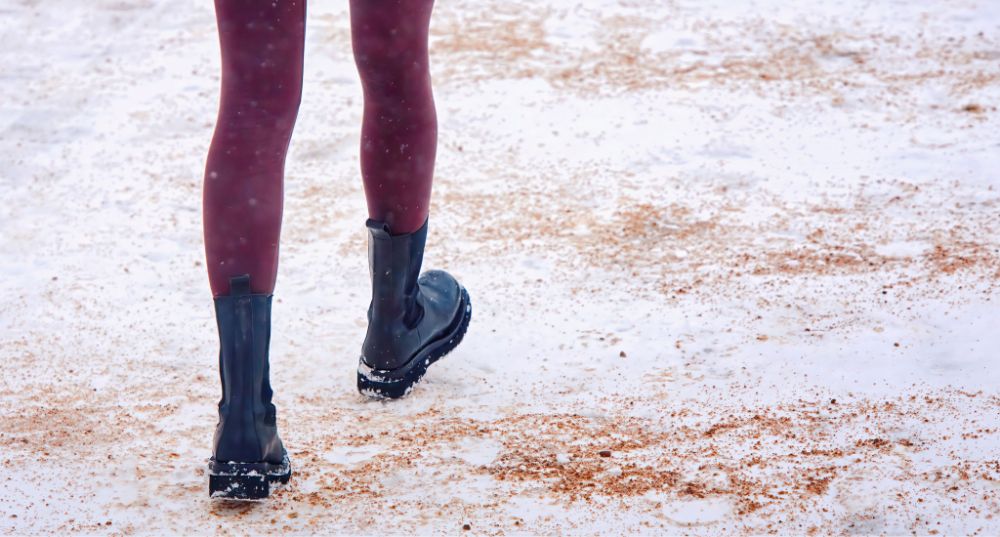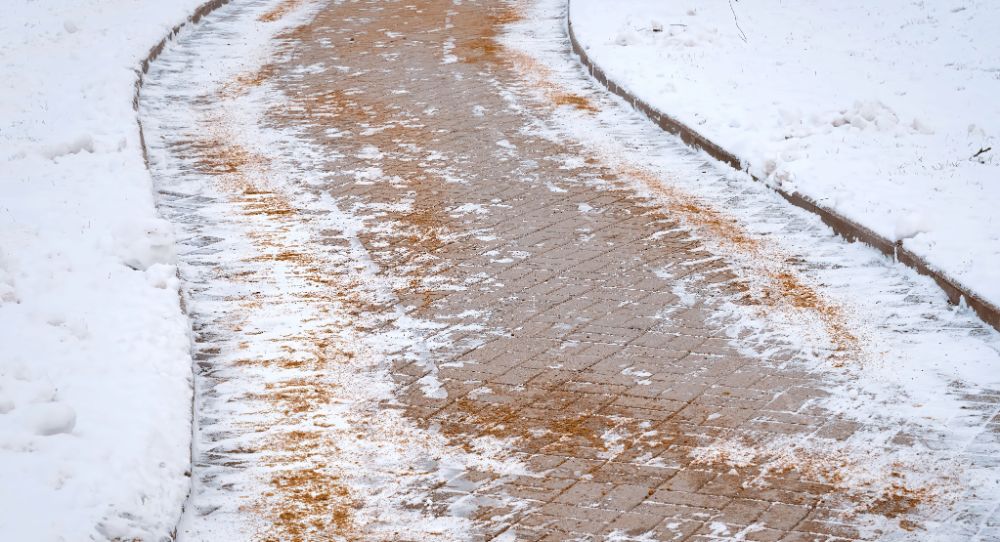You may have heard that sand is a good product to use on ice surfaces in the winter time. But how exactly does sand work to create traction on ice. Does sand melt the ice and if so how long does it take to work?
Sand is not a deicer and so it will not melt ice. However, it does add traction to ice instantaneously by providing grip on sidewalks, driveways and roads. While some sand is wet with salt water before being applied this is to help the sand stick to the ice and minimize loss from wind – not to melt the ice.
Sand may slightly slow up the melting of ice during the day due to increased friction as well as the sand being darker than the ice and thus absorbing more heat from the sun, helping to melt the ice. But ice melting is not sand's primary function and you should not expect sand to melt ice.
Below we’ll discuss in further detail why sand does not melt ice, what sand does do and how to most effectively use in on icy surfaces.
Does Sand Melt Ice?

Sand does not melt ice as it isn’t a deicer. Unlike ice melts, sand does not lower the freezing point of water, which is what causes ice to melt even in subfreezing temperatures.
Instead, as sand has an abrasive texture, it improves traction over ice and reduces roads from being slippery.
One of the main reasons ice is so slippery is that there is often a thin layer of water on top of the ice that can make the ice extremely slippery.
When sand is placed on top of the ice it helps to create a firmer grip over icy surfaces creating more traction for people, pets and vehicles. It'll be much safer to travel on and slips are much less likely.
When it comes to ice melting due to sand, this hardly happens – except in special conditions. As mentioned earlier, sand is not a deicer so it will not be lowering the freezing point of ice and cause it to melt like ice melts do.
If sand absorbs heat from the sun, however, there is a potential for it to melt ice faster than the ice would melt itself. But unless it is a particularly sunny day this impact is going to be minimal.
How Can Sand Help Ice Melt?
The main way sand helps to melt ice is when it is combined with salt or a deicer.
Sometimes sand is placed directly on top of the ice with nothing added to it. This adds friction but doesn't melt the ice at all.
However, sometimes sand is combined with a liquid mixture of water and salt or calcium chloride so the sand can provide immediate traction while the salt water mixture helps to keep the sand wet and stop it blowing away and encourages the ice to melt faster.
This sand/ice melt combination usually uses a much more diluted form of ice melt so it is going to melt ice much less that a pure ice melt would.
However, because salt deicers can be damaging to concrete this sand and diluted ice melt combination can be gentler on the concrete and be an overall better solution.
Other ways sand could help ice melt through heat from the sun as well as friction – although the impact of this is going to be fairly minimal.
When sand is placed on ice during a warmer sunny day, the heat from the sun will be absorbed into the sand, and it can help the ice melt quicker than if there was no treatment at all.
As ice is white, it reflects heat in comparison to sand that has a darker color and will absorb heat.
This tends to help on light covered surfaces like concrete but on darker asphalt roads and pavements (which are already black) the impact here is going to be negligible – if there is any impact at all.
However, when there is no sun and temperatures are frigid, the ice will not melt at all. At times, even when it is slightly sunny, if the temperatures are too cold, the sand will also not melt the ice as it is not an ice melt and it won't warm things up enough for the ice to melt.
There is also a possibility of the sand keeping the top layer of the ice warmer through friction. When tires and feet walk over the sandy surface over the course of the day, the friction generates warmth which makes it harder for ice to freeze over again.
Again this impact is extremely small compared to the overall outside temperatures and unlikely to have any noticeable effect on the quantity of ice melt happening.
If you’re looking to melt ice but don’t want to use salt, there are plenty of ways to do so.
If Sand Doesn't Melt Ice Why Is It Used?

While sand doesn't melt ice it can be an extremely important part of winter safety. This is because when placed on top of ice sand adds a good amount of traction and stops slipping.
In some areas temperatures are much too cold for regular salt or even the more effective calcium chloride to work effectively and so sand is the only way to create traction on top of the ice.
While not completely environmentally friendly sand can be a better alternative to salt as it is less likely to damage plants and is completely pet safe. When sand is unavailable people also turn to kitty litter as a way to add traction to ice.
Kitty litter doesn't melt ice either but provides traction just like sand does and it's actually made from the same substance so it can be another environmentally and pet friendly option.
Sand also won't damage concrete, which all forms of salt ice melts can often do when not used properly – learn how salt deicers damage concrete and how to avoid it.
Sand is also a cost effective solution for creating traction on ice and it can last for multiple days at a time.
For best result spread wet sand on top of the ice. This will stop the sand from blowing away and will reduce wastage.
Summary
Does sand melt ice?
- No, sand does not melt ice.
- Sand is not a deicer, it has a coarse texture that improves traction on icy sidewalks and roads, not melt ice.
- If sand does melt ice it is in minimal amounts and occurs because of friction and the absorbing the sun’s heat.




